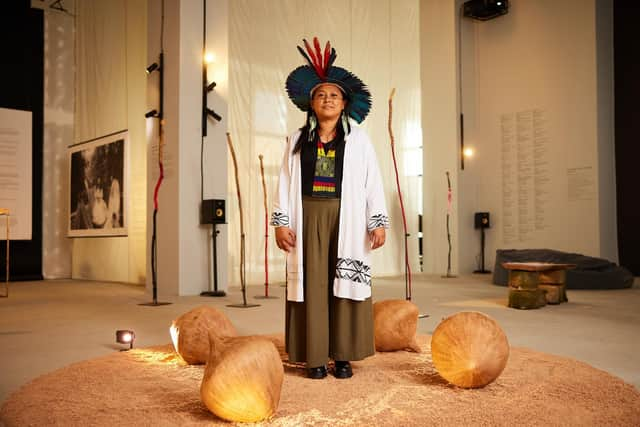Art collective Invisible Flock's latest project This is a Forest reimagines city as a forest
In the exhibition This is a Forest, which opened in Leeds this month, the collective presents new work created by them, alongside collaborations with UK and international artists from the Arctic to the Brazilian Amazon. Through sculpture, film, ceramics and installation, the show, which is part of Leeds 2023’s year of culture, tells the story of the artists’ journey across Leeds in an attempt to reclaim part of the city as a forest. It’s an admirably ambitious aim. The artworks and interventions explore ownership of earth, soil, air and water, posing questions about what land is actually worth to humanity in terms of ecological, health and social benefits as opposed to its purely financial value.
Based at the Yorkshire Sculpture Park and at The Hub, Wellcome Collection in London, the collective’s work has recently focussed exclusively on the environmental crisis in all its forms. Last year they curated the World Health Organisation’s Pavilion at COP27 in Egypt to showcase art that highlights the science and impact of climate change and they will be curating again at next year’s event. “For quite some time in our work we have been looking at the environment and ecosystems, and people and their land,” says Victoria Pratt, Invisible Flock’s creative director. “We have been running a two-year research project at Wellcome working with human rights activists and researchers, looking at ecosystems, climate change and mental health and exploring the links between them.”
Advertisement
Hide AdAdvertisement
Hide AdWhen the company was approached by Leeds 2023, it provided them with an opportunity to apply their thinking and research to a project closer to home. “We have worked away quite a lot and this was a chance to look at land change, here in Leeds and to create a long-lasting piece of environmental art through that work,” says Pratt. “We then went on this journey contacting landowners and working with Leeds Council exploring different sites in the city that have been left dormant – and we ended up with quite an extensive list.” In fact, they visited 50 sites across the city that had the potential to become forests.


“We went through the process of trying to get someone to agree to making that change – it was unsuccessful, which we kind of expected, because of various structural reasons, but going through that process was interesting,” says Pratt. “It allowed us to think about what the barriers are to having an ecologically safe city in the future. There is a lot of tree planting schemes in rural areas but in cities the temperature rise is higher and that same thinking isn’t being applied.”
In response Invisible Flock has created a new art film as part of the exhibition called No Economic Value to the Public that highlights the unrealised potential of these unused sites. The aim of the film is to encourage people to think about what those places could be and the real – rather than just economic – value of such places for communities. “We would like to start a much-needed conversation about these issues and it was really important for us to collaborate with other artists on this piece of work too,” says Pratt. “The ecological crisis we are facing is very complex and it needs to be considered from as many different perspectives as possible.”
Other artists’ work featured in the exhibition includes Yupirungawa by Vandria Borari, an indigenous leader, lawyer and ceramic artist from the Lower-Tapajos region in Brazil. Her sculptural piece features ancient seeds in ceramic, based on botanical remains found in Amazonian archaeological sites. British-Nigerian artist Nwando Ebizie’s multi-media work Last to Bloom/First to Fruit features sculpture, photography and text, imagining a speculative future, inspired by one of the sites – in Holbeck opposite Elland Road – where a school used to stand. Forest Bodies by Anushka Athique, a landscape architect and artist, is an 11-minute video and book that lyrically explores what it means to be a body moving through space. And artists Outi Pieski and Jenni Laiti, who are both Sami – an indigenous people inhabiting part of the Arctic Circle – bring their artwork Ovdavazzit: Forewalkers, an installation previously presented at the Venice Biennale, a forest-like structure made of Sami walking sticks.
Advertisement
Hide AdAdvertisement
Hide AdPratt hopes the exhibition will prompt audiences to engage with the issues it is highlighting. “Everyone has a connection to the natural world – it is innately human and it is about love. The call to action is to get out there and reconnect with nature. Basically, if the forest is thriving, humans are thriving.”
At Moda, Quarry Hill, Leeds until November 26. Free entry.